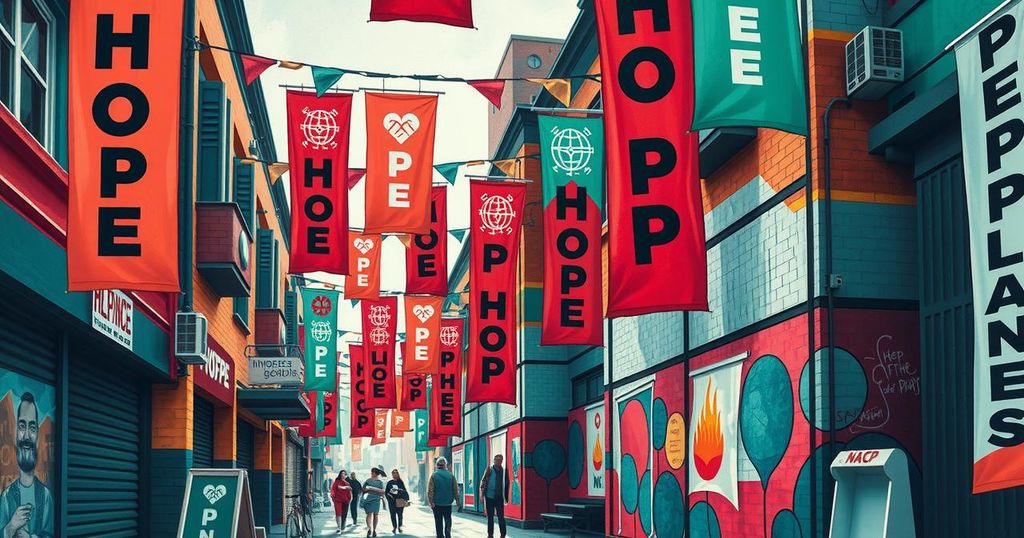Key to Coexistence: The Significance of the Gaza Uprising Against Hamas

The recent uprisings in Gaza signal hope for change as citizens call for the removal of Hamas. Coverage by mainstream media has been limited, often influenced by Hamas’s narrative. The protests highlight the need for international support to protect activists. Israel’s backing of the movement could help unify its citizens and foster a path toward peaceful coexistence.
There is increasing enthusiasm regarding the recent protests in Gaza, where countless citizens have united to call for the ousting of Hamas. Recognizing the potential risks of a renewed Israeli offensive, these demonstrators attribute the dire situation in the region to the actions of Hamas. This burgeoning movement is seen as a hopeful development amidst the longstanding conflict.
Mainstream media coverage of these protests has been surprisingly subdued. It has been suggested that many outlets are influenced by Hamas’s narrative, inadvertently perpetuating the misconception that Israel is primarily to blame for the turmoil. This misrepresentation persists despite overwhelming evidence to the contrary, allowing the cycle of misinformation to continue, particularly within Western discourse.
A prevalent social media meme illustrates this disconnect between perception and reality. The meme juxtaposes a campus protester with a Hamas terrorist, revealing a troubling dialogue that emphasizes the stark facts of the situation. The dialogue illustrates a disturbing alignment between some anti-Israel activists and the terrorist organization’s actions.
The current uprising in Gaza should be seen as an opportunity for change. While Hamas has shown willingness to consider a ceasefire proposed by Egypt, such actions are viewed with skepticism, potentially aimed at suppressing the uprising. The ideal scenario remains one where the citizens of Gaza reclaim their agency and influence over their region’s future, rather than relying solely on external interventions.
Despite the positive implications of the revolt, challenges persist. Reports from recently released hostages reveal a predominantly radicalized populace, and concerns are raised regarding the lack of visible dissent against the actions of Hamas. Consequently, it is crucial that the residents of Gaza confront and alter their prevailing culture in order to facilitate meaningful change.
The protesters face grave risks by opposing Hamas, with potential repercussions including death. Hence, there is an urgent need for international solidarity to support these brave individuals, reinforcing that their struggle represents a moral imperative for their collective future.
Israel must be the first to extend support for this uprising. Demonstrating a commitment to the genuine desire for peace, Israel can send a clear signal that its objective remains the dislodgment of terrorism rather than the annihilation of its neighbors. A collective endorsement of this movement could unify the Israeli public and present an opportunity for healing amidst political divides.
Citizens of Israel have been paralyzed by disagreement on how best to address the ongoing conflict. However, a unified stance in favor of the Gazan uprising could illuminate a path towards common goals. It may allow Israel to reestablish itself as a beacon of hope and integrity in international relations, while creating a foundation for a peaceful coexistence between both peoples.
While hope is rekindled, it is essential to approach the future with cautious optimism. The intrinsic societal changes within Gaza carry the most substantial potential to foster lasting coexistence, signaling an essential step towards resolution in this enduring conflict.
In conclusion, the recent protests in Gaza represent a pivotal moment for potential change, as citizens rally against Hamas in search of a new trajectory. The role of media and misinformation must be critically examined to ensure clarity in understanding the conflict. Israel’s support for the uprising could unify its population and reinforce a desire for coexistence. Fostering internal change within Gaza remains the most viable path toward achieving long-term peace and stability in the region.
Original Source: www.jpost.com








